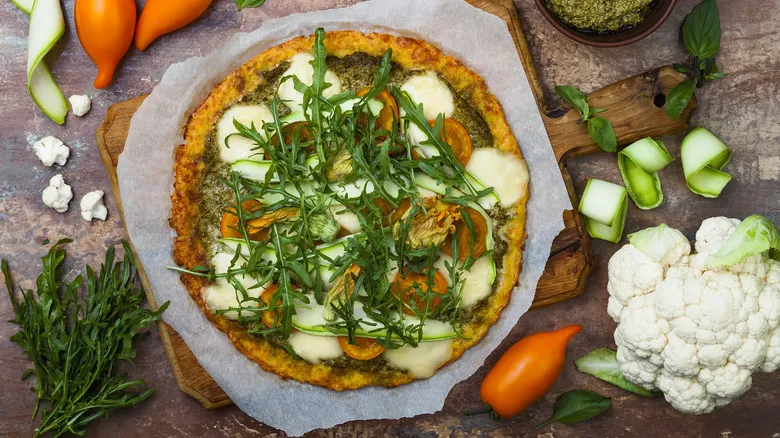1. 'Nduja
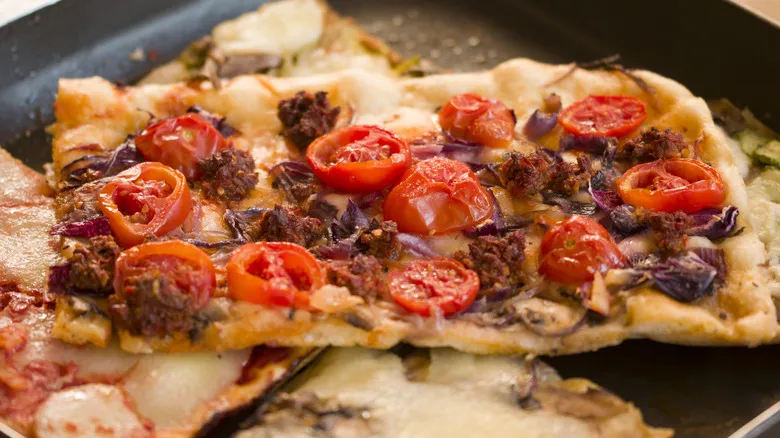
Want to enhance the spice level of your pizza? 'Nduja is a spicy red sausage hailing from the Calabria region of Italy. Its striking color and heat come from Calabrian chiles, which are blended with herbs, spices, and fatty ground pork, then encased and left to ferment in a warm environment. Occasionally, 'nduja is also smoked. After fermentation, the sausage is cured for several months, resulting in a spicy, tangy, and soft texture.
Tony Gemignani believes that 'nduja is an underappreciated pizza topping. Its soft consistency makes it easily spreadable, and its bold, fiery flavor pairs beautifully with mild cheeses like mozzarella and sweet ingredients such as roasted red peppers. You can incorporate it into your tomato sauce or add it directly to the pizza. However, Gemignani suggests applying 'nduja after baking. He explains, "People often put 'nduja on before baking, but it’s actually best to add it post-bake. With just a bit of residual heat, 'nduja reaches the perfect flavor."
2. Broccoli rabe
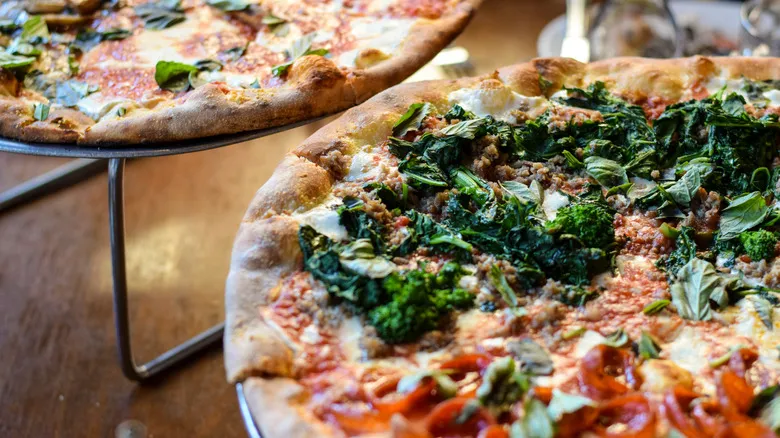
When we inquired with the chefs about any overlooked vegetarian toppings that could enhance bold flavors, both of them suggested broccoli rabe. Also known as rapini, this vegetable features buds that resemble typical broccoli florets, but that's where the resemblance ends. In fact, broccoli rabe is more closely related to turnips than to broccoli. It boasts long stems and an abundance of large, dark leaves, along with a notably bitter flavor.
Francesco Zimone remarked, "Broccoli rabe imparts a peppery taste and a hint of bitterness to pizza." If you wish to mitigate some of the bitterness, consider roasting or blanching the broccoli rabe before adding it to your pizza. Zimone suggests pairing it with sausage, as the sharpness of the rapini complements the richness of the pork, introducing earthy and nutty notes. To further balance the bitterness, you might add something sweet, such as cherry tomatoes or hot honey. A mild cheese like ricotta or burrata can also help soften the sharpness of the broccoli rabe.
3. Carnitas
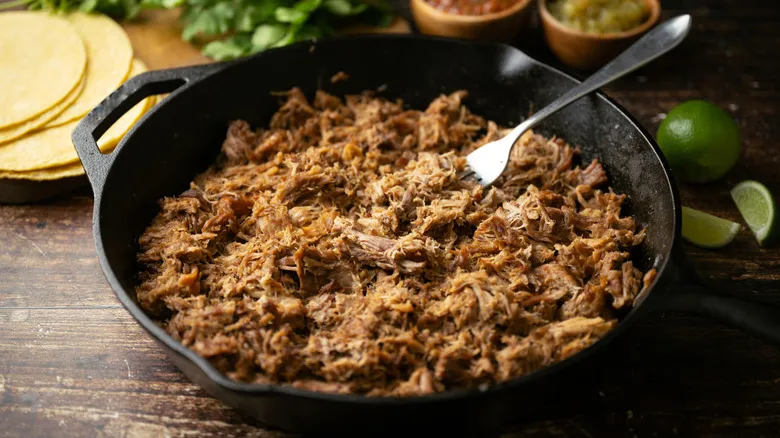
Carnitas is a quintessential Mexican dish, which is why many people don't associate it with Italian cuisine. However, Tony Gemignani believes that carnitas can surprisingly complement pizza. This dish is prepared by braising or simmering pork shoulder with a blend of herbs, spices, citrus juice, and occasionally lard. The pork is cooked slowly for several hours until it becomes incredibly tender and easy to shred. The final touch involves roasting the shredded pork to achieve a slightly crispy texture on the edges. It’s an excellent choice for crafting a Mexican-inspired pizza.
When we consulted Gemignani for tips on creating an outstanding carnitas pizza, he recommended, "Opt for a white pie—meaning no tomato sauce—then incorporate ingredients like mozzarella, Jack cheese, corn, a squeeze of lime, and sliced Serrano peppers." You can also draw inspiration from carnitas tacos by adding toppings such as chopped onions, cilantro, and pico de gallo. A creamy cilantro-lime sauce or an avocado-jalapeño sauce can enhance your pizza, adding a burst of freshness.
4. Peppadew peppers
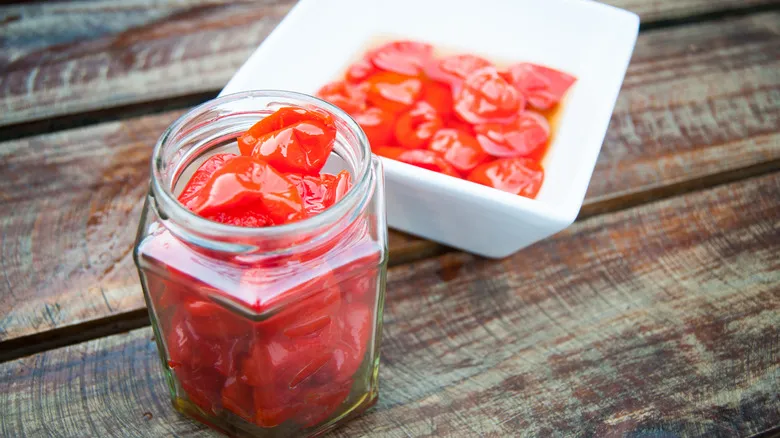
Customers frequently approach Tony Gemignani seeking unique pizza toppings, and one of his top recommendations is Peppadew peppers. These colorful peppers are more sweet and tangy than spicy, though they do possess a mild heat. Peppadew is the brand name of a South African company that markets these jarred peppers, which are actually piquanté peppers pickled in brine. You can often find jars of Peppadew peppers at your local grocery store or specialty shops.
Peppadew peppers are an excellent addition to pizza, as they contribute vibrant colors, textures, and flavors. The brining process helps maintain the peppers' color and crunch while enhancing their fruity and spicy notes with a touch of acidity. They complement a wide range of pizza toppings. For instance, Gemignani features a pizza on his menu at Tony's Pizza Napoletana called Grandma The Butcher, which includes sweet tomato sauce, mozzarella, garlic, oregano, pecorino, basil, pepperoni, salami, Italian sausage, smoked applewood bacon, hot coppa, arugula, and, of course, peppadews.
5. Purple potatoes
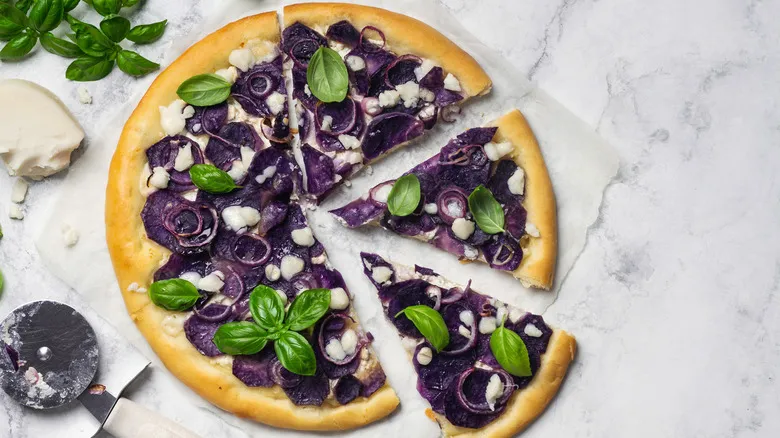
Another intriguing pizza topping that Tony Gemignani recommends for those seeking something distinctive is purple potatoes. These vibrant tubers are indigenous to the Andes mountains in South America (as are all potatoes) and come in a range of shades, from deep purple to violet and blue. The flesh inside is also colorful and can sometimes be marbled. There are various types of purple potatoes, most of which are relatively small compared to other potatoes, and they can be either round or oblong.
Purple potatoes have a flavor profile similar to other varieties like fingerlings and russets. You can use them just like any other potatoes on your pizza. A traditional Italian potato pizza features thinly sliced potatoes, olive oil, and rosemary. As the potatoes bake, they soften and take on a creamy texture that eliminates the need for cheese. However, we wouldn’t fault you for wanting to add cheese as well. You could also incorporate bacon or prosciutto for an extra salty kick, or fresh basil for a pop of greenery that contrasts beautifully with the purple tones of the potatoes.
6. Hazelnuts

Hazelnuts are incredibly versatile and often found in chocolates and baked treats like cakes and cookies. However, they can also be a delightful addition to pizza. Francesco Zimone recommends incorporating them into a dessert pizza. He shares his favorite combination: "Chocolate, strawberries, banana, and hazelnut; a simple yet sensational dessert — definitely no marinara!" This sweet and crunchy pizza serves as a fantastic after-dinner indulgence or a delightful sweet breakfast option for brunch.
With their rich, buttery flavor, hazelnuts complement fruits and chocolate beautifully. Additionally, they provide a satisfying crunch to the typically soft toppings found on dessert pizzas. You can chop the nuts and sprinkle them on the pizza raw, but roasting them will deepen their flavor and add a hint of sweetness. Regardless of whether you use them raw or roasted, there is one important step to take before baking with hazelnuts: removing their skins, which can be quite bitter. The easiest method to peel hazelnuts is to roast or blanch them first, then simply rub off the skins.
7. Figs
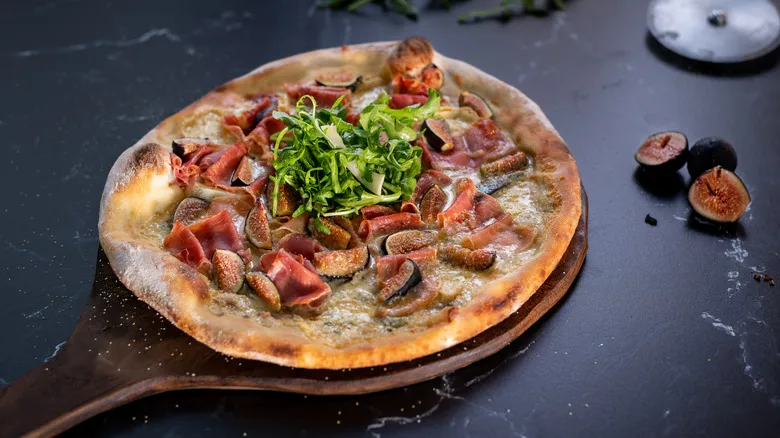
If you're looking to infuse your pizza with vibrant color and intriguing flavors, consider incorporating figs. Francesco Zimone notes, "They offer a delightful blend of sweet and savory, and can complement a variety of bold flavors, making the pizza vegan, meaty, or extra cheesy." The luscious interior provides a tender texture, while the seeds add a satisfying crunch.
Figs are among the oldest cultivated fruits in existence. What sets them apart is that the flowers of the fig tree develop inside the plant's green or purple pods. These flowers transform into fruits containing unique seeds, with each fig pod housing multiple fruits. Every part of the fig pod is edible, including the fruit, seeds, and skin. While fresh figs are ideal, you can also find them dried or preserved.
As Zimone mentioned, figs pair beautifully with a diverse range of ingredients. Common combinations include prosciutto, goat cheese, arugula, and caramelized onions. The secret to a delicious fig pizza lies in balancing the fruit's sweetness with other flavors such as salty, umami, and bitter. Spicy elements like pepperoni or soppressata picante also complement figs wonderfully.
8. Squash blossoms

Take a look at the menu at Tony's Pizza Napoletana, and you'll discover a variety of distinctive pizza toppings that are rarely found on traditional American pizzas. One topping that Tony Gemignani particularly enjoys is squash blossoms. He frequently suggests it to customers seeking something out of the ordinary yet delicious. The vibrant colors of the blossoms enhance the visual appeal, while their texture and flavor are both delicate and subtle.
Squash blossoms can be harvested from various squash plants, including zucchini, pumpkin, and crookneck squash. These flowers are usually yellow or orange and feature long, slender petals. You might have encountered squash blossoms or zucchini flowers as an appetizer in Italian restaurants, where they are often fried and can be filled with ingredients like ricotta cheese, herbs, and tomatoes. They make a delightful addition to pizza, as their mild flavor, with hints of floral and squash notes, complements other toppings beautifully. You can choose to add whole or sliced blossoms to your pizza.
9. Corn
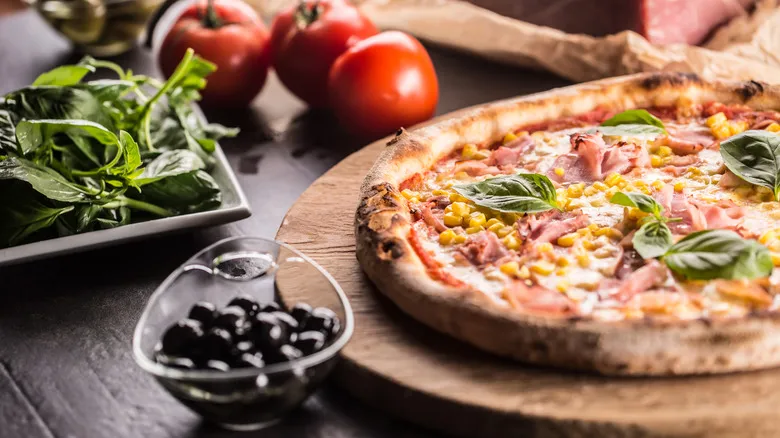
Many individuals may hesitate to add corn to their pizza, but some chefs argue that it is a highly underrated topping. The vibrant yellow kernels bring a delightful burst of color, while their texture is both crisp and juicy. The unique flavor of corn can also create a pleasing contrast with other ingredients. Chef Francesco Zimone noted that it pairs surprisingly well with prosciutto, stating, "The corn adds a subtle sweetness." It also complements mild and tangy cheeses, spicy sausages like chorizo, and fresh herbs beautifully.
Another fantastic aspect of corn is the wide variety available, along with numerous preparation methods before adding it to your pizza. You can choose from sweet corn, heirloom blue corn, or white corn. While canned corn is an option, many chefs emphasize the importance of using fresh corn. If you opt for fresh, you can boil it or grill it for a smoky flavor. You can either sprinkle the kernels over your pizza or use whole corn ribs for added visual appeal and texture.
10. Tuna

Tuna can be quite a polarizing pizza topping, particularly for those who weren't raised on seafood pizza. As Tony Gemignani noted, "It's a well-liked topping in Italy, so European customers recognized and appreciated that pizza, but it required some explanation for our American patrons." You might assume that the tuna would dominate the pizza with its fishy taste, but when combined with the right ingredients, that's not the case at all.
Any variety of canned tuna will work, though some chefs suggest using tuna packed in olive oil for an added richness. Francesco Zimone advocates for jarred tuna in olive oil. A classic Italian pizza, tonno e cipolla, features tuna alongside tomato sauce, mozzarella cheese, red onions, and olives. Alternatively, you could draw inspiration from Japanese sashimi and add thinly sliced ahi tuna to your pizza after it comes out of the oven. Once you’ve experienced tuna on your pizza, you might feel encouraged to explore other seafood toppings like clams or smoked salmon.
11. Calabrian chiles
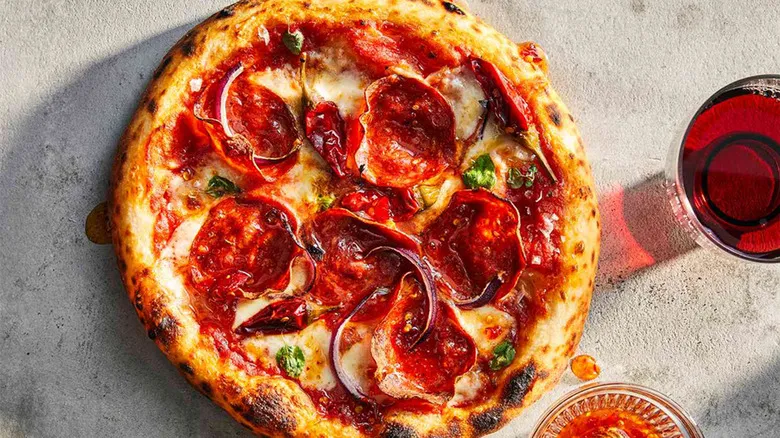
One zesty ingredient that both chefs agree is fantastic for adding a kick to your pizza is Calabrian chiles. Also known as Calabrese peppers, these small red chiles hail from the Calabria region of Italy and are a fundamental part of Southern Italian cuisine. They offer a fruity and spicy flavor with a moderate level of heat. While they will certainly spice up your pizza, they likely won’t overwhelm your palate unless you have a low tolerance for spicy foods. Outside of Italy, they are usually available jarred in olive oil, and you might also find Calabrian chile flakes and ground Calabrian chile powder.
If you enjoy hot sauce or spicy peppers on your pizza, there's a strong chance you'll appreciate Calabrian chiles as well. You can slice them and add them directly to your pizza or incorporate them into your sauce. Tony Gemignani mentioned, "Calabrian peppers cooked into a vodka cream sauce is delightful." The fruity, piquant flavor complements a wide variety of ingredients. For instance, Franceso Zimone's Caserta pizza at L'Antica Pizzeria Da Michele features fior di latte, rapini, Italian sausage, smoked provolone, and Calabrian chiles.
12. Spam
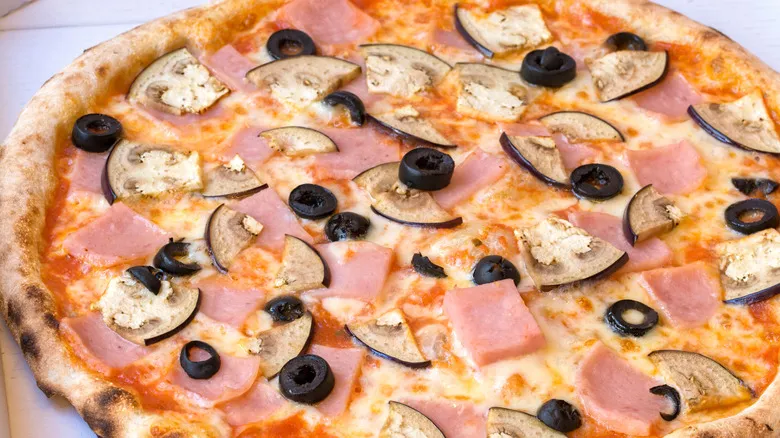
Whether you love it or loathe it, there's no denying that Spam is an exceptionally adaptable ingredient. This canned meat product made its debut in 1937, promoted as an economical option that could be incorporated into a wide range of recipes. During World War II, Spam was included in the rations for Allied soldiers, which helped it gain global popularity. Since then, Spam has found its way into everything from breakfast meals to sandwiches, soups, and fried rice. Many even consider it a delicious pizza topping.
Spam boasts a salty, savory flavor that can serve as a great alternative to traditional pizza meats like bacon or ham. You can chop it into cubes or slice it into thin strips, pairing it with a variety of vegetables and cheeses. Some enthusiasts even combine Spam with pineapple for a Hawaiian-inspired pizza. Chef Tony Gemignani shared a creation he made on the show "Bar Rescue," where he was challenged to craft a post-apocalyptic pizza using Spam. He recounted, "I soaked it in pineapple syrup and cut it into long triangular pieces. Surprisingly, it turned out to be a really tasty pizza."
13. Fried kale
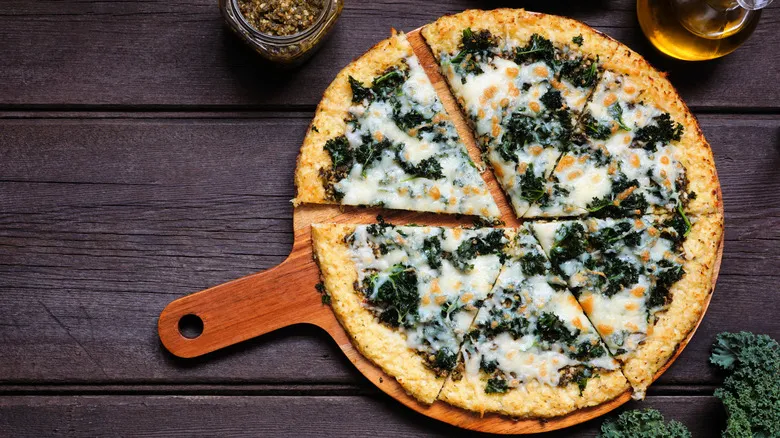
Kale surged in popularity across the United States in the early 2000s, yet it has long been a staple in Tuscan cuisine. If you travel to Tuscany, you'll encounter kale featured in various dishes such as soups, polenta, and salads. This cruciferous leafy green also pairs exceptionally well with pizzas—some might argue even better than other greens. For instance, while spinach tends to wilt quickly and release excess moisture, kale retains its structure and crisps up beautifully.
Often associated with vegetarian or vegan pizzas, kale can also play a vital role in a rich, meat-laden pie. Its subtle bitterness can balance the richness of indulgent cheeses and meats. Tony Gemignani creates a unique pizza with kale that is irresistibly delicious. He first fries the kale to achieve a crispy texture, then combines it with Muenster cheese, Calabrese peppers, honey, applewood smoked bacon, and lemon. "I call it the Eddie Munster," he shares.
14. Soppressata picante

Cured meats are excellent choices for pizza toppings. In the United States, pepperoni and sausage reign as the most favored cured meat options. However, for a truly authentic Italian experience, Tony Gemignani suggests trying soppressata picante. He describes it as "the pepperoni of Italy." This spicy, salty, and fatty salami offers a similar flavor profile to traditional American pepperoni, though there are notable distinctions between the two.
Soppressata picante is a spicy cured salami originating from Southern Italy. It is made from pork, lard, and a blend of spices, including chili powder, with some variations incorporating wine. The mixture is packed into casings, secured with twine or netting, and hung to cure for a minimum of 45 days. When sliced, the meat showcases a vibrant red hue with appealing marbling from the fat. Many pizzaiolos prefer soppressata picante over pepperoni due to its spiciness, larger size, and flatter shape, which yield bigger slices. Additionally, its higher lard content renders the meat moist, while pepperoni can often be on the drier side.
15. Mortadella

When discussing cured meats, Francesco Zimone suggests trying mortadella as a delightful alternative to traditional options like pepperoni and prosciutto. This pale pink cold cut, adorned with white flecks, hails from Bologna in Italy's Emilia-Romagna region. It is crafted from cubes of pork and pork fat, seasoned with spices such as black pepper, and often includes pistachios for added flavor. The pork fat contributes a wonderfully silky texture and a rich taste. While mortadella resembles bologna, the fat is present in pockets rather than being evenly mixed throughout. Additionally, bologna can be made from a blend of meats, whereas mortadella is exclusively pork.
Mortadella can be enjoyed on its own or in sandwiches, such as the famous muffuletta from New Orleans. It also makes a fantastic topping for pizza, enhancing it with its richness and subtle spice. Zimone shared a useful tip for maximizing the flavor of mortadella on pizza: "You want it warmed, not cooked." Cooking mortadella can dull some of its flavors. To maintain the delicious taste of this exquisite meat, consider adding it to your pizza after it has been removed from the oven, allowing the residual heat to warm it gently.
Recommended
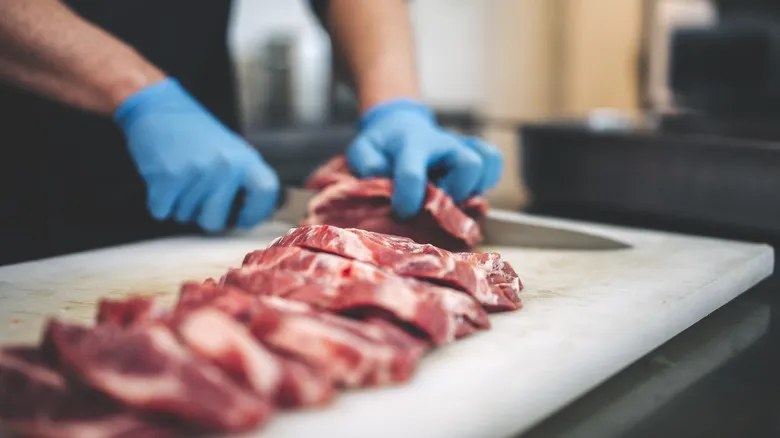
The Easy-To-Make Mistake That Will Start Your Pork Dishes Off On The Wrong Foot

The Common Mistake That Will Ruin The Texture Of Your Clams

Cheese In Ice Cream Sounds Ridiculous, But Trust The Process

What Ingredients Are In Lemon Pepper Seasoning?
Next up

